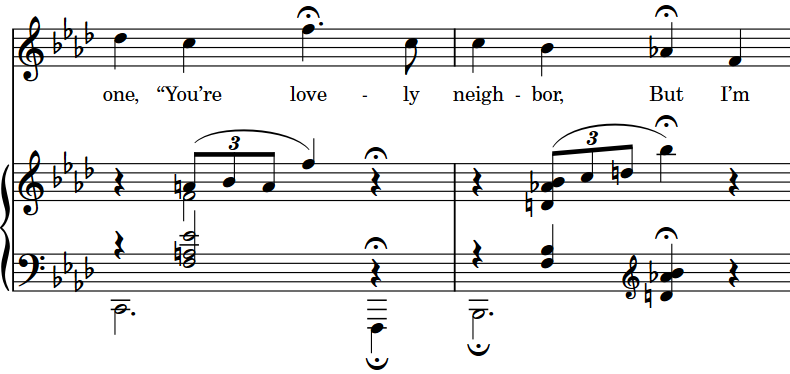Positions of holds and pauses
Holds and pauses are placed above the staff by default in single-voice contexts, and are shown on all staves at the closest rhythmic position available; for example, if a single staff has a fermata on the last beat in the bar, it is shown above the bar rests on the other empty staves. For staves with multiple voices, fermatas are also shown inverted below the staff.
You can move holds and pauses to different rhythmic positions in Write mode. They are positioned by default according to your settings in Engraving Options.
You can move holds and pauses graphically in Engrave mode; however, this does not change the rhythmic positions to which they are attached.
You can change the default positions of all holds and pauses project-wide, and values for the minimum gaps around holds and pauses, on the Holds and Pauses page in Engraving Options.
Fermatas
Fermatas are positioned horizontally so that they are centered on front noteheads in the first voice column, regardless of the stem direction of notes.

Fermatas affect the overall tempo of the piece, so all players must be able to see where they occur. Therefore, fermatas are shown on all staves at the same rhythmic position, or the rhythmic position of the note, chord, or rest that corresponds with the end of the fermata, including over a bar rest if a staff has no notes in that bar.
Breath marks
Breath marks are placed above the top line of the staff by default, at the end of the note to which they apply; that is, they appear just before the following note.
Breath marks apply only to the staff to which they were added, as they do not affect the overall tempo, but instead only indicate to a single player or group of players a suitable place to break their line in order to breathe.
Caesuras
Caesuras are positioned at the top of the staff, with the top staff line passing through the middle of the caesura and the bottom of the caesura resting on the second staff line. They are commonly placed at the end of a bar, before the barline.
Caesuras are automatically added to all staves at the same rhythmic position, immediately to the left of the notehead or barline to which they were input. They are not linked to noteheads, and adjust note spacing to create a clear gap.